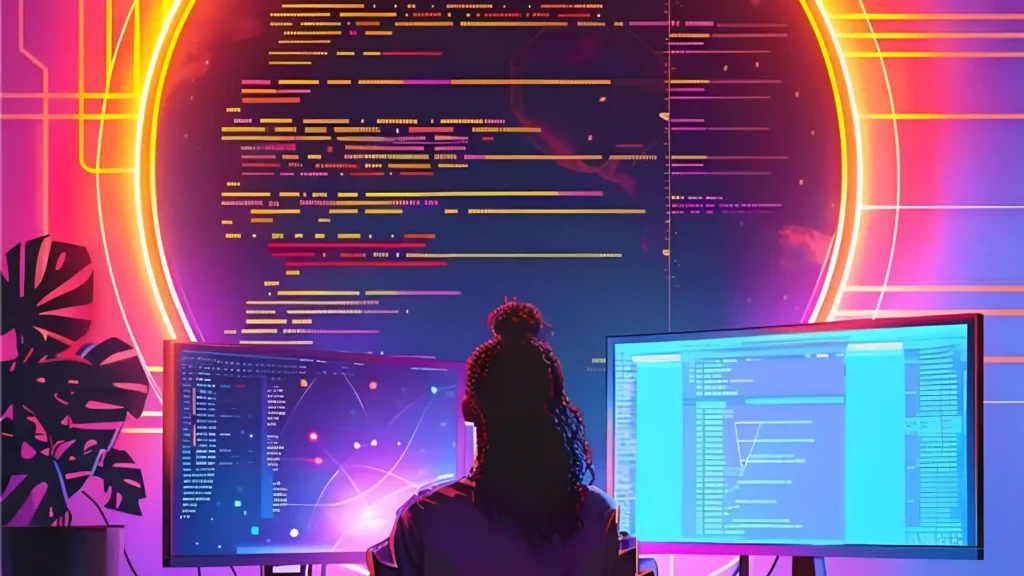In the world of modern software engineering, development is evolving from rigid, manual processes to more flexible, intelligent methods. At the heart of this transformation lies vibe coding — a new-age approach that blends creativity with automation through AI-powered development tools.
So, what is vibe coding?
Vibe coding is a cutting-edge paradigm in AI mobile app development that leverages powerful AI tools and large language models (LLMs) like ChatGPT, Claude AI, Microsoft GitHub Copilot, and OpenAI’s Codex. It empowers developers to stay creative, productive, and in flow — or the “vibe.”
Rather than typing out every line of code, developers simply express their coding intent in natural language, and AI translates it into functional, executable code. This shift gives rise to AI agent-assisted development, where smart tools work in real-time to auto-complete code, generate UI structures, and automate repetitive tasks.
With vibe coding, developers can focus on what truly matters: solving complex problems, designing intelligent systems, and staying in their optimal mental zone, while AI agents take care of the groundwork.
Why Vibe Coding Matters Now More Than Ever
We’re now fully immersed in the era of AI mobile app development, where speed, intelligence, and user personalization aren’t just advantages — they’re expectations.
Here’s what’s accelerating the shift toward AI-powered development:
- AI voice agents, chatbots, and AI calling agents are managing customer conversations 24/7, reducing human effort and response time.
- Smart AI apps are being built using tools like Vapi, Cursor, Claude, and Perplexity AI, delivering predictive, contextual, and multilingual experiences.
- Global markets now demand software that works seamlessly across devices, platforms, and languages, which is only possible through AI-driven website development and app frameworks.
The New Pressure on Developers
As expectations rise, developers today are being pushed to:
- Deliver faster across frameworks like React Native, Flutter, and web platforms
- Build and maintain complex AI voice agent and AI calling agent ecosystems
- Avoid burnout, fatigue, and mental block — especially when handling multiple deployments
- Stay innovative while adapting to tools like Galileo AI, GitHub Copilot, or Replit
Why Vibe Coding is the Ultimate Answer
This is where vibe coding shines. Unlike traditional development workflows, vibe coding introduces real-time collaboration between AI app developers and intelligent tools. It reduces the cognitive load by generating boilerplate code, solving logic structures, and offering AI-driven design recommendations.
The best part? You don’t have to force productivity. Instead, vibe coding lets you ride your natural creative energy, supported by AI co-pilots like Microsoft Copilot, Claude AI, and Vapi.
With vibe coding, developers can:
- Code faster and smarter
- Build innovative, AI-powered apps and websites
- Align work with their energy cycles
- Boost delivery without burning out
Traditional Coding vs Vibe Coding
| Aspect | Traditional Coding | Vibe Coding |
|---|---|---|
| Fixed Hours | Yes | No |
| Follows Mood | No | Yes |
| AI Tool Usage | Low to Medium | High |
| Flexibility | Low | High |
| Focus on Creativity | Less | More |
| Productivity | Time-based | Energy-based |
How to Implement Vibe Coding in Real Life
Vibe coding isn’t just another buzzword—it’s a revolutionary mindset reshaping how today’s AI app developers write code. It’s about aligning your natural energy rhythms with AI-powered development tools to boost focus, reduce burnout, and build innovative digital solutions.
If you’re in the field of AI mobile app development, AI website development, or building intelligent platforms like AI voice agents and AI calling agents, here’s how to start implementing vibe coding in your workflow:
Step 1: Understand Your Energy Curve
Your brain isn’t built for non-stop productivity. It cycles through phases of focus, fatigue, and creativity. Vibe coding encourages you to align your most critical tasks with these natural energy peaks, especially when building complex AI agent workflows or refining core backend logic.
Sample Vibe Coding Energy Schedule:
- Morning (9 AM – 12 PM): Peak focus window — Ideal for coding backend logic, debugging AI calling agent scripts, or architecting AI workflows in platforms like Replit or Cursor.
- Afternoon (1 PM – 4 PM): Low energy zone — Best for testing, refactoring, or leveraging tools like Claude AI, Perplexity, or GitHub Copilot to generate code snippets, document APIs, or fix bugs.
- Evening (5 PM – 8 PM): Creative window — Use this time for UI design, chatbot persona building, or prototyping new features in AI mobile apps using AI design tools like Galileo AI.
Pro Tip: Instead of fighting mental fatigue, let your vibe guide your focus. Build AI-powered solutions when your energy is aligned.
Step 2: Choose the Right AI Tools for the Right Tasks
The core of successful vibe coding lies in leveraging global, intelligent tools that match your development needs. Whether you’re an AI agent developer, mobile engineer, or working on next-gen voice AI, using purpose-driven tools is crucial.
Here’s a breakdown of AI tools based on use cases:
| Task | Tool | Purpose |
|---|---|---|
| Code Completion | GitHub Copilot | Predicts and completes code snippets as you write. |
| Debugging & Troubleshooting | Cursor | Lets you chat directly with your codebase and debug through conversation. |
| Full-Stack Prototyping | Replit | A powerful cloud IDE for building and deploying projects quickly. |
| Technical Research | Perplexity AI, Claude AI | Ask complex dev or API questions and get simplified, accurate responses. |
| Voice Agent Integration | Vapi | Build AI-powered calling agents or voice-enabled features. |
| UI/UX Generation | Galileo AI | Convert text prompts into responsive, production-ready UI designs. |
Use tools as creative partners, not just utilities. The right tool at the right time can 10x your output.
Step 3: Work in Flow Blocks, Not Time Blocks
Instead of working in rigid 8-hour shifts, vibe coding encourages working in short, intense blocks of energy followed by recovery. This reduces mental fatigue and helps you stay in the “zone” for longer.
Sample Vibe Block Routine:
- 90-minute focus sprint – Deep, uninterrupted work on priority tasks.
- 15-minute break – Stretch, hydrate, or take a quick walk.
- 1-hour recharge – After 2 sprints, step away to eat, nap, or relax.
By aligning your work with flow science rather than clock hours, you’ll notice a boost in quality, clarity, and mental sharpness.
Limitations of Vibe Coding in AI Mobile App Development
While vibe coding revolutionizes how developers approach AI app development, it’s essential to understand its limitations to use it effectively.
1. It Doesn’t Replace Essential Structure
Even in the age of AI voice agents and AI calling agents, traditional project management practices like deadlines, teamwork, and collaboration remain critical. Vibe coding complements but does not eliminate the need for solid planning and coordination.
2. Not Ideal for High-Pressure Launches
When working on tight deadlines, such as launching an AI mobile app or AI website development project within days, you might not have the luxury to wait for your “vibe” to align. Speed and structure often take precedence over creative flow.
3. Over-Reliance on AI Tools
AI-powered assistants like GitHub Copilot, Vapi, or Claude AI can boost productivity, but developers must retain core problem-solving skills. Blindly trusting AI without understanding the underlying logic can lead to errors and reduce code quality.
4. Scaling Challenges in Large Teams
In large development teams working on complex AI agent projects, if each developer follows their vibe and workflow, maintaining synchronization and effective communication can become challenging. Consistent processes and collaboration tools are still necessary to keep projects on track.
Tips for More Effective Vibe Coding in AI Development
To make vibe coding a long-term and efficient practice, especially in today’s fast-paced AI mobile app development environment—consider applying these smart and simple strategies:
1. Track Your Productive Hours
Whether you’re an AI app developer or working on complex AI voice agent systems, knowing your peak performance hours is crucial. Use tools like RescueTime, Notion, or Google Calendar to monitor and map your energy levels throughout the day.
2. Build a Vibe-Friendly Workspace
A productive coding vibe starts with your environment. Make sure your setup includes:
- Natural lighting
- Minimal distractions
- Calm playlists for focus
This supports creative work like AI website development or AI calling agent flows.
3. Set Micro-Goals for Daily Wins
Instead of large, vague tasks like “Finish Project,” break your day into smaller objectives:
- ✅ “Build Login UI”
- ✅ “Integrate API with Vapi”
- ✅ “Fix error in voice call flow”
This aligns better with the flexible rhythm of vibe coding and speeds up delivery of AI-powered apps.
4. Embrace Breaks as Brain Boosters
Taking strategic breaks between sprints helps your mind rest and subconsciously solve complex problems—especially when debugging or integrating with tools like Claude AI or Perplexity AI.
5. Experiment With Global AI Tools
Every developer vibes differently. Explore what works best for your use case from the global toolkit below
| Tool | Role in Vibe Coding | Website |
|---|---|---|
| GitHub Copilot | Predicts & autocompletes code snippets | copilot.github.com |
| Replit | Full-stack cloud IDE for rapid AI app development | replit.com |
| Cursor | Chat with and debug your codebase conversationally | cursor.so |
| Claude AI | Summarizes large docs and answers development queries | claude.ai |
| Perplexity AI | Smart AI assistant for instant research and logic | perplexity.ai |
| Galileo AI | Converts text prompts into UI mockups instantly | usegalileo.ai |
| Vapi | Build AI voice & calling agents for mobile/web apps | vapi.ai |
How We Use Vibe Coding at Equitysoft Technologies
At Equitysoft Technologies, we don’t just follow trends — we evolve with them. In today’s fast-paced digital world, vibe coding isn’t just a technique; it’s our philosophy.
We believe real productivity doesn’t come from longer hours but from smarter execution. Our team of expert AI app developers leverages vibe coding to stay in sync with their natural energy levels while using world-class tools to innovate faster and smarter.
Here’s How We Do It:
- ⚡Rapid Development with GitHub Copilot & Replit
We use GitHub Copilot to autocomplete code in real time and Replit for building and deploying cloud-native applications, boosting speed without compromising quality. - 🧠 Smarter AI Agents with Vapi
Our engineers build intelligent AI voice agents and AI calling agents using Vapi, enhancing user interactions and streamlining business communications. - 📚 Research Made Easy with Claude AI & Perplexity AI
Quick research and documentation? We turn to Claude AI and Perplexity to summarize, reference, and integrate APIs with accuracy, cutting down hours of manual work. - 🧘 Structured Flow, Creative Output
Instead of rigid time blocks, our team works in high-energy “vibe blocks” to maintain peak focus. Paired with automation tools, this approach leads to better results and less burnout.
Thanks to this methodology, we’ve successfully delivered AI-powered mobile apps, interactive websites, and voice-first platforms with high performance and global client satisfaction.
Final Thoughts: Is Vibe Coding the Future?
Absolutely — and the future is already here.
Vibe coding aligns perfectly with the demands of:
- ✅ AI Mobile App Development
- ✅ AI Voice and Calling Agent Platforms
- ✅ AI Website Development and Automation Solutions
With the right global AI tools and a mindset focused on creativity, flow, and energy, vibe coding empowers developers to:



